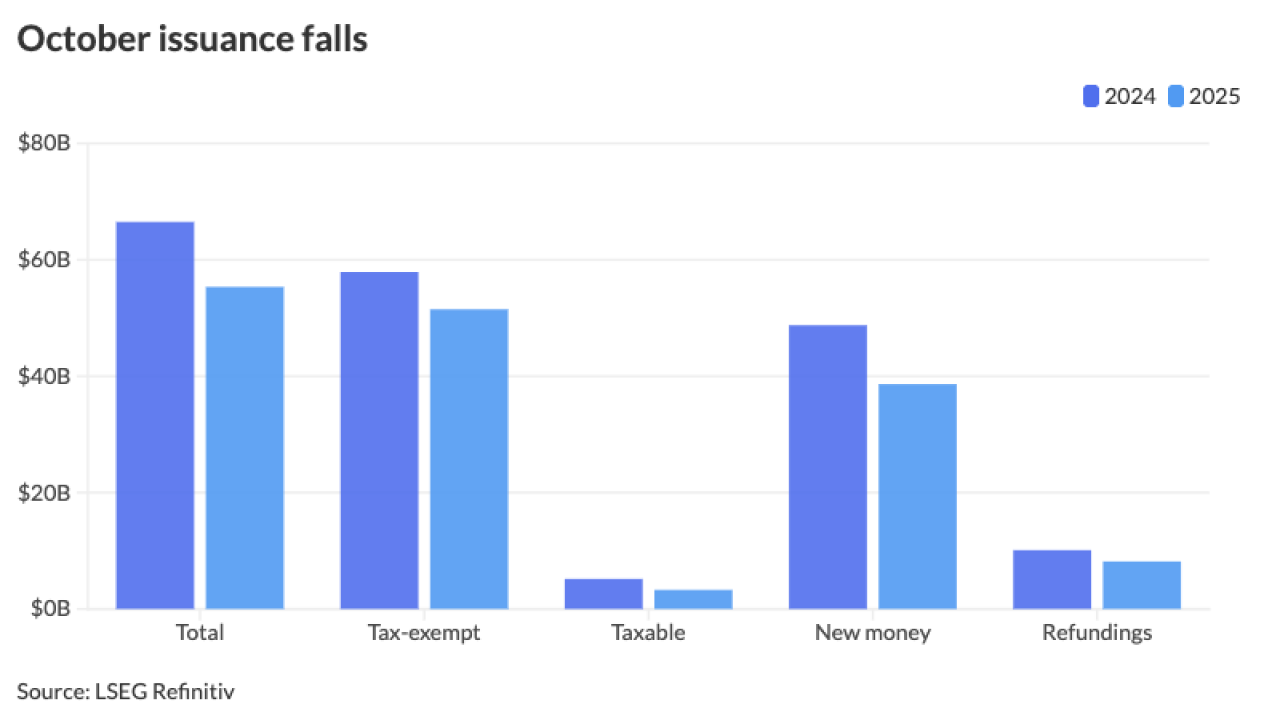BlackRock will convert its $1.7 billion BlackRock High Yield Municipal Bond Fund to an active exchange-traded fund, the latest example of shifting investor demand from mutual funds to ETFs.
"Active ETFs are becoming an integral part of investor portfolios around the world, with financial advisors increasingly incorporating them into their models-based practice," said a BlackRock spokesperson.
The firm's decision for a mutual fund-to-ETF conversion underscores this growing demand, the spokesperson said, noting, "We continue to see use cases for mutual funds and view ETFs and other investment vehicles as complementary as they often serve different client segments."
Blackrock's conversion is significant because the bank will give up a lot of fee income from mutual fund structure, said Pat Luby, head of municipals at CreditSights.
"So they're clearly communicating that they see growth in the ETF structure," he said.
Luby puts the total muni ETF universe at 103. Money has been moving out of mutual funds into ETFs and separately managed accounts (SMAs),
ETF ownership was at $122.4 billion in Q2 2024, up 1.7% quarter-over-quarter and 15.7% year-over-year, per Fed data.
Meanwhile, mutual funds owned $775.1 billion in Q2 2024, rising 0.5% from Q1 2024 and 1.5% from Q2 2023, though market participants attribute the slight increase to investors not pulling money out, some inflows, and probably a larger part is market value gains.
Mutual funds are still down 13% since the end of 2020.
The main factor in the growth of ETFs is fees, Roberto Roffo, a 30-plus year muni veteran, recently told The Bond Buyer.
"As investors have become more conscious of fees, they have been drawn to the lower-fee structure of ETFs, which on average are 50% lower than mutual funds," he noted.
Additionally, ETF growth has been more significant than mutual funds as the "liquidity of ETFs and being able to trade them all day long versus waiting until a mutual fund strikes its NAV at the end of the day is a big draw," Roffo said.
This growing preference for ETFs over mutual funds played a role in some firms' and mutual funds' decision to convert mutual funds to ETFs.
Mutual fund-to-ETF conversions gained traction in 2021 when there was a lot of buzz around them, said Dan Sotiroff, a senior manager research analyst on the passive funds research team at Morningstar.
"Out of the gate, a fair number of mutual funds filed for [conversions]," but it was not the larger mutual funds or firms in most instances, he said.
Since then, conversions have slowed despite the growing popularity of ETFs, Sotiroff said.
There have been 118 completed mutual fund-to-ETF conversions since 2021, three of which have been muni mutual fund-to-ETF conversions: two from J.P. Morgan in 2023 and one from Morgan Stanley's subsidiary Eaton Vance in 2024, according to Morningstar Direct data.
BlackRock's muni mutual fund-to-ETF conversion, which is expected to be completed in early February 2025, will be at least the fourth.
"Even though the ETFs are becoming a lot more popular, you can't take every mutual fund that's out there and convert it into an ETF," Sotiroff said. "It just doesn't work that way."
However, he noted mutual fund-to-ETF conversions make a "little bit more sense" in fixed income.
"One of the things that's a big hang up for a mutual fund to convert to an ETF is capacity concerns," Sotiroff said. "If you're in an equity strategy and you can only handle $5 billion, by the time you get to like $2 billion or $3 billion, you're going to think about shutting that thing down, because you want to preserve your advantage over the market. You don't want to take in new money; otherwise, it's going to ruin your edge."
In fixed income, he noted there is more flexibility and "to the extent that those constraints exist, it's not as strong as it is in the equity world."
For example, three of AllianceBerstein's four mutual fund-to-ETF conversions are fixed-income products. The fourth is an equity product, said Brett Sheely, head of ETF specialists at AllianceBernstein.
The firm first converted its high-yield mutual fund to the AB High Yield ETF in the spring of 2023, growing to $150 million from $60 million in the fund. The remaining mutual fund-to-ETF conversions happened this year, he said.
"We definitely see more demand for the ETF wrapper, whether it be for the lower fees, trading flexibility, transparency, enhanced tax efficiency," Sheely said. "We saw an opportunity to find new buyers through the ETF, give investors the wrapper that they want, get all the benefits from the wrapper and start to round out our broader ETF products."
AllianceBernstein did not share if they plan to convert any muni mutual funds to ETFs, but Sheely said the firm continues to explore opportunities within the muni market, of which muni ETFs have been a "core component" for the firm.
Firms are looking at where customers and the asset class will be in 2026 and 2027, prompting some to convert mutual funds into ETFs, Luby said.
While he is unsure how many mutual fund-to-ETF conversions will happen within the muni market, the market may only be able to support so many ETFs, he noted.
"If an asset manager wants to be in the space in five years, they need to be taking steps now," Luby said.





